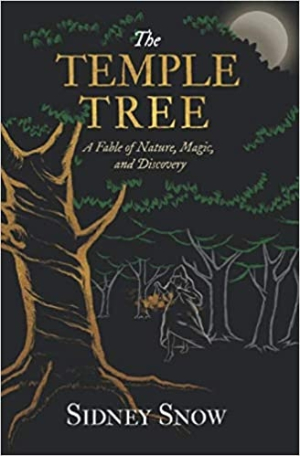The Temple Tree
A Fable of Nature, Magic, and Discovery
The Temple Tree is an inspirational fable about the many ways that people move through the world and about the difficult work of cultivating inner peace during moments of loss and self-doubt.
Sidney Snow’s gentle teaching fable, The Temple Tree, models weathering changes and finding wholeness through mutual care, compassion, and nourishment.
Ali retreats to his family’s attic, seeking a quiet place to deal with his father’s death. Caught between a memory and a dream, he falls into a reverie. It mimics an ancient story that his father told him about a temple tree. This retelling makes enduring philosophies accessible, and human pain manageable, through listening to a tree.
Already renowned and millennia old, the temple tree is as a golden god for the village people who live in close proximity to its canopy. It bears three unchanging fruits and gives shade and shelter to birds, forest creatures, and a budding poet and sage, Buddavahni. Everything is idyllic. But then, one of the unchanging fruits sickens and falls, disrupting the villagers and the tree’s faith in itself. The trouble that follows transmutes domestic difficulties into fabled wisdom.
Utilizing a framing device to revisit older narrative traditions, the book’s tone mimics oral teaching tales, especially those of the Buddha. It employs an artificial, archaic syntax that evokes the rhythms of such tales, especially as they were presented in translation through British colonialism. Its stripped-down characterization, language, and story lines are used to convey serious social messages, which vary in their cultural relevance from timeless and eternal to conservative and potentially harmful.
While the tree’s gender varies according to its viewers’ perceptions, there’s an overall focus on models of masculinity and fatherly wisdom, emphasized through the prevalence of men among the book’s human characters. The only named woman character, Popo, is Buddavahni’s wife; her main identity is as his domestic and emotional support. Among the men, only one, Veedeesheemee, behaves outside the bounds of traditional masculinity: he wears women’s clothes in the evenings. The explanation for this—that he lost his mother at a young age and finds comfort in wearing her clothes—aligns gender-nonconforming presentation with psychological trauma and does not inform the larger story. Comparatively, masculinity is vaster, more individualized territory than any other in the story.
The tree itself is the story’s most complex character, and the book’s omniscient narration allows access to its anthropomorphized inner world. Unlike Buddavahni, who is insightful and unflappable, the tree fluctuates through emotional highs and lows, many of which which threaten to dull its shine. This god’s-eye view into the book’s central nonhuman character provides a model for addressing self-awareness, self-doubt, grief, depression, and anxiety. The tree’s emotional distress about losing its fruit is sympathetic, and the communal response to its grief is a realistic, compassionate rendering of moving through difficult circumstances at collective and individual levels.
The book includes diverse, nurturing messages that encourage self-knowledge. Although not all of the characters’ story lines are wholly resolved, and though the narrative arc skews meditative, the central relationship between Buddavahni and the tree is a point of consistency, making The Temple Tree an inspirational fable about the many ways that people move through the world and about the difficult work of cultivating inner peace during moments of loss and self-doubt.
Reviewed by
Letitia Montgomery-Rodgers
Disclosure: This article is not an endorsement, but a review. The publisher of this book provided free copies of the book and paid a small fee to have their book reviewed by a professional reviewer. Foreword Reviews and Clarion Reviews make no guarantee that the publisher will receive a positive review. Foreword Magazine, Inc. is disclosing this in accordance with the Federal Trade Commission’s 16 CFR, Part 255.

